|
After the Wright brothers historic flight in
1903 and later demonstrations in Europe, the military potential of
manned aircraft was obvious to all the major powers. Yet it was only in
early 1914 that Germany sent its first pilots and aeroplanes to the
colonies. The First World War broke out a few short months after their
arrival and they were pressed into action with little experience, no
weapons and very few spare parts.
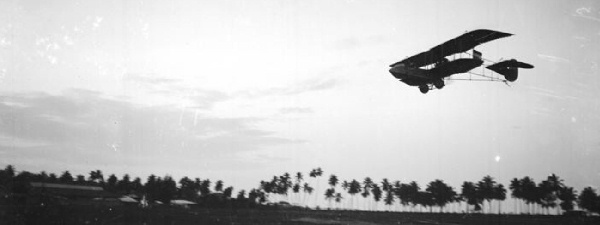
Bruno Büchner's Otto Pfalz Biplane over
East Africa 1914
Photo by Walther Dobbertin from
Bundesarchiv /
WikiCommons
The Air War over the Colonies
German East Africa
A civilian pilot, Bruno Büchner, was the first pilot to fly in
German Africa. He was sponsored by a confectionary company, Rudolf
Hertzog, to take part in various air shows in Africa with an Otto/AGO pusher
biplane made by Pfalz (a "pusher" biplane is one that is "pushed" by
its propeller from behind as opposed to one being "pulled" by
a propeller in front as
later became standard). He first stopped off in German South West
Africa in May 1914 to fly several displays, then travelled to German
East Africa to fly shows there but the events were cancelled by the
outbreak of the First World War. In August 1914 he, his mechanic and
the biplane were incorporated into the Schutztruppe.
During one of the
first reconnaissance missions over the Northern coastline of German East
Africa Büchner was shot down by a British gunboat. He managed to land
on the coast but was badly injured and the plane severely damaged. Both
were out of action. The plane was repaired at Dar-Es-Salaam and Büchner's place was taken by Oberleutnant
Erich Henneberger,
a Schutztruppe officer who had previously passed his pilot's test in
Germany. Before he saw action he crashed during a test flight and was
killed. His observer, Leutnant der Reserve von Gusmann, was badly
injured and the plane again was wrecked.
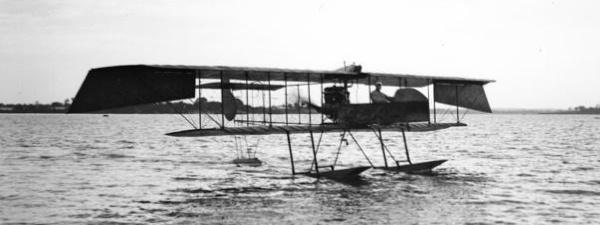
Büchner's Biplane after its
conversation with to a Seaplane, East Africa 1914
Photo by Walther Dobbertin from
Bundesarchiv /
WikiCommons
This time the plane was rebuilt
on floats as a seaplane to assist the SMS Königsberg in time for Büchner's recovery from his injuries. Soon however, petrol supplies ran
low and the plane was dismantled. The engine was later used to power a flatbed railway
carriage for a brief time.
German South West Africa
When Büchner sallied to German South West Africa, two other pilots were
onboard the same ship sent to form a new Schutztruppe air force. One was Leutnant Alexander
von Scheele, an army pilot
who was appointed to command the new Schutztruppe air force, the other
was Willy Trück, an Aviatik factory pilot. A third pilot, the
Austro-Hungarian, Paul Fiedler, joined them shortly after.
They had two
aeroplanes between them, an Aviatik and a Roland, both biplanes. Trück and Fiedler
initially performed test
flights on the aircraft under the supervision of Scheele and it was
reported that neither aircraft was particularly fit for flight in the
the climate of South West Africa. Before the aeroplanes could be
replaced however, war broke out and they were pressed into service.
Von Scheele now took over the role of piloting the Aviatik from Trück, while
Fiedler flew the Roland. Both pilots flew many sorties over
South African lines during the campaign, gaining valuable information on
enemy troop movements (Fiedler was also a keen and useful photographer) and dropping
bombs on enemy positions. Both pilots were injured and both
planes were damaged to various extents throughout the campaign by crashes
and enemy gunfire often meaning their grounding for weeks at a time.
The last mission was flown by von Scheele in May 1915. The Schutztruppe
surrendered in July and both planes were destroyed before falling into
enemy hands.
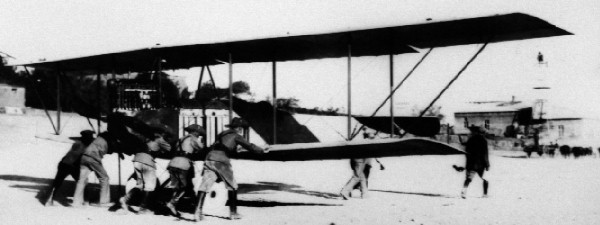
One of the Schutztruppe Biplanes in South
West Africa 1914
Photo from Tsumeb Museum /
WikiCommons
Tsingtao
The first German pilot in Tsingtao was Franz Oster with his
privately purchased Rumpler Taube monoplane. Although he was not a
military or naval pilot his aircraft impressed the visiting Prince
Heinrich of Prussia and the naval command in
Tsingtao. In July 1914 the imperial navy sent two aeroplanes to Tsingtao. Both aeroplanes were
again Rumpler Taube monoplanes.
The pilots were Gunter Plüschow and Friedrich Müllerskowski. Müllerskowski was badly
injured and his aeroplane wrecked in a test flight in July 1914 leaving
Plüschow as the only active pilot with an aeroplane in Tsingtao when war broke out.
During
the Siege of Tsingtao he ran spotting missions over the Japanese lines and claimed
to have shot down a Japanese aeroplane with his pistol. When the garrison surrendered and went into captivity he was
ordered to escape by flying his aeroplane into neutral China, where he crash
landed and started an epic journey back to Germany.
Cameroon
Two aeroplanes, a Rumpler Taube monoplane and a Jeannin monoplane
(probably also a Taube design) were sent to the Schutztruppe in Cameroon during 1914. They arrived just
before the outbreak of war and were still unassembled in their packing
crates when they were captured by British troops. The two pilots
designated to fly these planes,
Jasper von Oertzen and
Eugen Kirch had not
yet left Germany. The airfield to
which they had not yet been delivered was being built at Garua in the
North of the colony by Hans Surén, a Schutztruppe officer who had
previously passed his pilot's test in Germany. The captured aeroplanes
were sent, still cased, to assist the newly formed South African air
force but did not see action.
The Flyers
This is a list of all the known
pilots and aircrew either in the colonies or intended for use in the
colonies. Not all actually flew in action. All were qualified pilots
with previous flying experience in Germany or Austria-Hungary (with the
exception of von Gusmann who flew briefly as an observer in East
Africa). Curiously not all these pilots appear on the official list of
the 817 military and civilian pilots who qualified in Germany before the outbreak of the First World War
(as seen on the
Frontflieger.de and
Autoveteranen.de websites), though some such as Henneberger and Plüschow
are clearly seen in pre-war photographs wearing their army (or navy)
pilot's badges on their left breast.
German East Africa
Bruno Büchner (1881-1948) was born in
Ebersach, Saxony. He gained his pilot's licence (No. 53) in 1911. He was
a civilian pilot who sailed with his wife to Africa to perform flying
displays for the National Exhibitions in Windhoek and Dar-Es-Salaam.
When the war broke out he offered his services to the Schutztruppe of
German East Africa (as described above). Büchner and his wife were
interned by the British in East Africa during the war where he suffered from malaria.
After the war he returned to Germany and bought land on
the Obersalzberg Mountain including Berchtesgaden, which he sold to Adolf Hitler
in 1938.
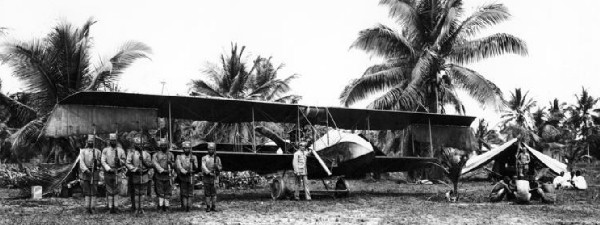
Büchner with his Biplane and an Askari
Guard, East Africa 1914
Photo by Walther Dobbertin from
Bundesarchiv /
WikiCommons
Oberleutnant Erich Henneberger
(18__-1914) became an army officer in 1907, originally with the rank of
Leutnant. After passing his pilot's test he was transferred to the East
African Schutztruppe in June 1914. When Büchner was recovering from wounds received
when shot down by a British gunboat, Henneberger took his place as
German East Africa's only pilot. However, before he saw action, he
crashed and was killed during a test flight in November 1914.
Leutnant der Reserve Wilhelm Gutzmer von
Gusmann (18__-1917) was Henneberger's observer, he was injured in Henneberger's
fatal crash in 1914 but later made a full recovery in hospital. He then fought with the
Schutztruppe until he died of wounds received at the Battle of Mahenge
in June 1917.
German South West Africa
Leutnant Alexander von Scheele
(18__-1939) was an army
officer who passed his pilot's test (No. 169) in 1912. In 1914 he was appointed to
command the new Schutztruppe air force. He flew many combat and
reconnaissance missions over South African lines during the war in an Aviatik
biplane (see above). In May 1915 he was injured in a crash and did not
recover to fly again before the end of the campaign. He was kept as a
prisoner of war at Okahandja until the end of the war. He initially
emigrated to Argentina before returning to Germany to join the Luftwaffe
where he attained the rank of Oberst. He was killed while flying as a
passenger in an air accident in Spain shortly before the outbreak of the
Second World War.
Leutnant Paul Fiedler (1884-1955) was
born in Sternberg in Austria-Hungary (modern ternberk in the Czech
Republic) and joined the Austrian
army in 1903. He was promoted to the rank of Leutnant der Reserve in
1909 and retired into civilian life. In 1910 he passed his pilot's
licence (No. 19 in the Austro-Hungarian system). He sailed to German
South West Africa to fly test flights for the early Schutztruppe air
force. In August 1914 he was conscripted into the Schutztruppe with the
rank of Leutnant. He flew many combat and reconnaissance missions over
South African lines during the war In a Roland biplane (see above).
After the surrender of German South West Africa, Fiedler along with
other non-regular members of the Schutztruppe gave his word not to take
up arms against the Entente and was released on parole. Following the
war he briefly returned to Austria, then again to South West Africa
where he managed a farm until 1926 when he again returned to Europe.
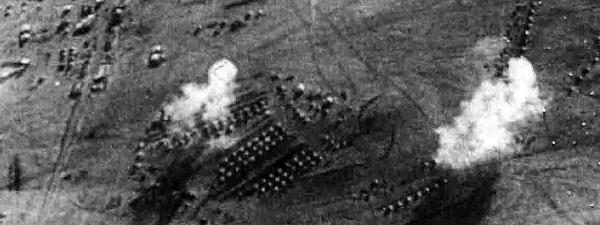
Bombardment of South African troops by
Paul Fielder's Roland Biplane, South West Africa 1914
Photo by Paul Fielder from
Koloniales Bildarchiv /
WikiCommons
Willy Trück (1889-1981) was an Aviatik factory
pilot, having passed his pilot's licence in February 1914 (No. 658), he sailed to German South West Africa to fly test flights in the Aviatik aircraft for the early Schutztruppe air force. In August 1914 he
was conscripted into the Schutztruppe, although von Scheele took over the
piloting of the Aviatik in wartime. After the surrender of German
South West Africa, Trück along with other non-regular members of the
Schutztruppe gave his word not to take up arms against the Entente and
was released on parole. Following the war Trück stayed on in South West
Africa as a businessman, pilot and farmer. He died in Cape Town in 1981.
Hauptmann Konrad Pueschel (1879 -__)
was first commissioned as a Leutnant in the 3rd Brandenburg Field
Artillery Regt in 1898, transferred to the 39th Kurmark Field Artillery
Regt in 1900 and then to the I. Artillerie Abteilung of the South West
African Schutztruppe from
1904-08. For his service in the Herero Rebellion he was awarded the
Prussian Crown Order 4th Class with Swords. He returned home to serve in
the 24th Holstein Field Artillery Regt with the rank of Oberleutnant. He passed his pilots licence (No.
64) in 1911 and soon after returned to service in South West Africa as
an inspection officer for the Landespolizei with the rank of Hauptmann
(from 1912). Although he never flew there he was a strong supporter of
the idea that the Schutztruppe needed aircraft. He returned to Germany
on leave in April 1914 and was prevented from returning to Africa by the
outbreak of the First World War.
Tsingtao
Franz Oster (1869-1933)
was born in Bad Honnef, near Bonn but had lived in Tsingtao since 1899 as
an engineer and factory owner. In 1911 he passed his pilots licence (No.
94) and privately purchased a Rumpler
Taube monoplane, shipping it to Tsingtao the following year. His
debut flight was not until July 1913 but as such he was the first pilot to
fly in
Tsingtao and in all of the German overseas territories. He did not fly
combat missions during the siege of Tsingtao but he was made prisoner of
war when the city fell and spent the rest of the war in a Japanese
prisoner of war camp. In 1920 he returned from Japan to Tsingtao where he
lived the rest of his life.
Leutnant Friedrich Müllerskowski
(1886-19__) joined the German infantry in 1907 and transferred to the
Seebatallion in 1912. He passed his pilot's test in Germany before being
posted out to Tsingtao where he was
badly injured in a test flight days before the outbreak of war. He thus
did not see active service during the siege of Tsingtao, being released
from hospital only shortly before the German surrender. For the
remainder of the war he was held as a prisoner of war in Japan at the
Kumamoto and Kurume camps and returned to Germany in 1919 where he
rejoined the army. In 1920 he retired with the rank of Major.
Leutnant-zur-See Gunther Plüschow
(1886-1931), nick-named the "Dragon Pilot" due to a tattoo of a dragon
on his left arm, was a naval officer who passed his pilot's test after
only three days of flying in February 1914. He was sent straight to
Tsingtao with his aeroplane arriving in July. When war broke out he was
the only German airman available for active duty in Tsingtao. During the
siege he ran spotting missions in a Rumpler Taube over the Japanese
lines and claimed to have shot down a Japanese aeroplane with his
pistol. When the garrison surrendered and went into captivity he was
ordered to escape by flying his aeroplane into China, where he crash
landed and started an epic journey back to Germany. When the garrison surrendered and went into captivity
he escaped and made his way back to Germany via China, Japan, America
and Gibraltar where he was briefly captured by the British and taken to
England, only to escape once more and make his way back to Germany via
Holland. He was the only German prisoner to escape from a British
mainland POW camp during either World War. He also wrote several books
including one on his experiences in China and his journey back to
Germany called "Escape from England" (published by
Ripping
Yarns). After
the war he explored uncharted areas of Chile and Patagonia where he died
in a flying accident in 1931.
Linienschiffsleutnant Viktor Klobucar
(1878-1965) of the
Austro-Hungarian imperial and royal navy passed his pilot's test in
1913. In 1914 he was an officer on the SMS Kaiserin Elisabeth at
Tsingtao and became good friends with Gunther Plüschow . Although he was
not posted in this role as a pilot, nor did he have an aeroplane at
Tsingtao, he is included on this list simply as another potential pilot
in the German colonies. He fought at the siege of Tsingtao and was
captured by the Japanese. He spent the rest of the war in the Japanese
prisoner of war camps at Kumamoto, Kurume and Aonogahara before being
released in 1919.
He died in Zagreb in 1965.
Cameroon
Leutnant Hans Surén (1885-1972) earned
his commission as a Leutnant in the imperial German army in 1905. He
passed his pilot's test in 1912 (No. 260) and the following year was posted to the
Cameroon Schutztruppe.
In 1914 he was ordered to prepare an airfield at Garua in the North of
the colony and was presumably intended to pilot one of the aeroplanes
sent from Germany. Surén never flew in Cameroon as the aeroplanes never
arrived at his airfield, both having been captured by the British
while en route. After the war he wrote books extolling the values of a
healthy sporting life, nude bathing and aryan supremacy. Although Hitler
was an admirer of his books, Surén spent the last years of Nazi rule in
prison having fallen foul of the regime.
Hauptmann Jasper von
Oertzen (1880?-19__) had passed his pilots test in September 1912
(No. 290) and then served as a company leader in the German army's 1st
Flying Battalion ("1. Flieger-Batallion"). At this time he had
previous previous colonial experience and was thus considered ideal for
leading the new Cameroon air force. The First World War broke out before
he set sail for Cameroon. He then served as commander of the 1st Flying
Detachment ("Flieger-Abteilung Nr 1") on the Western Front.
Hauptmann Eugen Kirch (18__-19__) earned his
commission as a Leutnant in the German 28th Infantry Regiment (2nd
Rhineland) in 1895. He served in the Cameroon Schutztruppe in 1912 and
on his return to Germany in 1913 passed his pilot's test. He was one of
the pilots designated to fly the aeroplanes sent to Cameroon in 1914 but
war broke out before he set sail, thus leaving him stranded in Germany.
During the First World War he served in the 3rd Flying Battalion ("3.
Flieger-Batallion") and later commanded the 4th Flying Battalion on
the Western Front.
The Aircraft
Büchner's Otto/AGO Pusher Biplane
Made by: Pfalz in Speyer
Crew: One/Two
Construction: Wooden frame with canvas covering
Engine: Rapp 100 hp engine
Top Speed: 100km/h (although some experts doubt it could actually have
attained this speed)
Length: 10.8m
Wingspan: 14.9m
Armament: No armaments have been confirmed although photographs show
what appears to a metal tube slanting down from the cockpit. This may
have been an aid in dropping improvised bombs.
Markings: "Pfalz-Fugzeugwerke. GMBH" with
"Speyer a.Rh." underneath in smaller
print can be seen underneath the cockpit on both sides in early photos of the plane.
Rieth (see sources below) states the company name was also displayed on
the wings. These markings would have been eradicated when the aircraft
was repaired and her canvas replaced.
Other Modifications: After Henneberger's crash the plane was re-built as
a seaplane with floats instead of wheels. The fuselage was also
re-constructed with a flatter less aero-dynamic front as is noticeable
in period photographs.
Von
Scheele's Aviatik P-14 Biplane in
German South West Africa
Made by: Automobil und Aviatik AG in Mülhausen
Crew: One/Two
Construction: Wooden frame with canvas covering
Engine: Argus 100 hp engine
Top Speed: 105 km/h
Length: 8m
Wingspan: 14m
Armament: Initially equipped with a rifle for use if it crash landed in
hostile territory but later equipped with bombs (improvised from
10cm shells dropped from tubes attached to sides of the aeroplane) and rifle grenades, both of which were dropped on South
African positions
Markings: Period photographs show "A.ü.Aviatik A.G." with "Mülhausen"
and two letters, possible "IE" under it on the right side of the
tailplane.
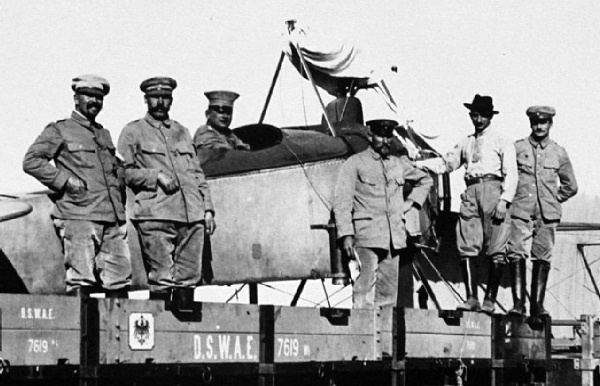
Von
Scheele and his Aviatik packed for Transport
Photo from Tsumeb Museum /
WikiCommons
Fielder's LFG Roland Biplane in German
South West Africa
Made by: LFG Roland (at the Luft-Fahrzeug-Gesellschaft in Berlin
according to Flugsport Magazine)
Crew: One/Two
Construction: Steel frame with canvas covering
Engine: Mercedes 100 hp engine
Top Speed: 115 km/ph
Length: ___
Wingspan: ___
Armament: Initially equipped with a rifle for use if it crash landed in
hostile territory but later equipped with bombs (improvised from
10cm shells dropped from tubes attached to sides of the aeroplane) and rifle grenades, both of which were dropped on South
African positions
Markings: At least one period photograph shows large block lettering on
the right side of the fuselage, unfortunately the wing obscures the
letters in the photograph.
Plüschow's Rumpler Taube Monoplane in
Tsingtao
Made by: Rumpler
Crew: One/Two
Construction: Wooden frame with canvas covering
Engine: Argus 100 hp engine
Top Speed: 95km/ph
Endurance: 4 hours
Length: 10.3m
Wingspan: 14m
Armament: Initially equipped with no weaponry aside from Plüschow's own
Parabellum pistol but later armed with bombs (improvised 4lb bombs made
from dynamite and scrap iron packed into "Sietas, Plambeck & Co"
coffee tins detonated by a cartridge on impact)
Markings: None can be positively confirmed from photographs.
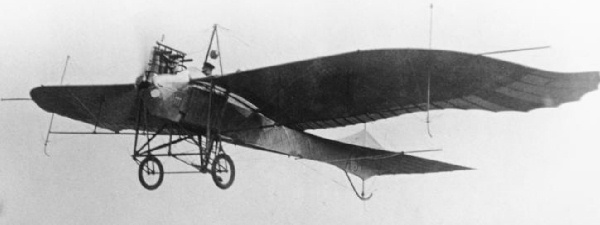
A Rumpler Taube
in Training in Germany prior to the First World War
Photo from
Bundesarchiv /
WikiCommons
Additional Notes
Flying Conditions in the Tropics
These early flying machines were not the safest of aircraft at the best
of times. The climatic conditions in the colonies only made things
worse. Hot and cold patches of thermal air pockets caused the planes to
be tossed up and down by hundreds of feet at a time, while flying in
African humidity conditions made it very difficult to attain
lift in midday heat. To help with lift the aircraft were kept as light
as possible, although all these aeroplanes were two seaters they were
usually flown with only the pilot on board, having also to work as
observer and bomber. These climatic reasons combined with a lack of
suitable runways and the aeroplanes'
general state of repairs made crashes common. Most were not fatal but
injuries were frequent and the aircraft often had to be rebuilt.
Maintenance of the Aeroplanes
It seems from brief mentions that most of the planes were accompanied by
a trained mechanic (though these mechanics are not always noted as often
as the pilots). Ground crews and workmen to fix the aeroplanes were
recruited from the local Schutztruppe or civilians. All the aircraft
suffered damage in wartime from crashes, enemy gunfire and general wear
and tear, and had to be repaired often without the proper spare parts.
Engine parts were fashioned at railway depots, new propellers and struts
were carved by carpenters and linen to cover the wings was replaced by
curtains at least once in South West Africa.
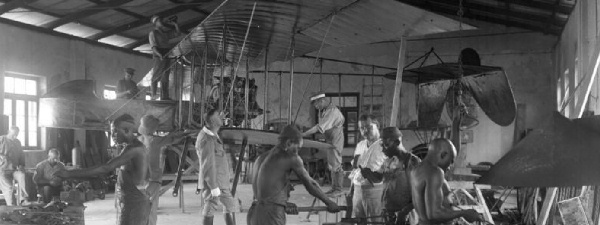
Bruno Büchner's Biplane undergoing
Repairs, East Africa 1914
Photo by Walther Dobbertin from
Bundesarchiv /
WikiCommons
The mechanics who worked on the German South
West African aircraft were-
Gefreiter Otto Meier (Fiedler's mechanic) plus additional
Schutztruppe wartime mechanics, Gefrieter Klotz, Gefreiter Kirsch,
Reiter der Reserve Dörgeich
and Reiter der Reserve Siedler) and
Unteroffizier Holzmacher, Gefreiter Nietzsche and Gefreiter Schulz (von Scheele
and Trück's mechanics- Trück himself also worked as a mechanic on the
aeroplanes in wartime while von Scheele piloted them).
Opposing Entente Aircraft in Africa
Germany only just managed to get the first few aeroplanes out to the
colonies in the months before the First World War broke out but the
Entente powers were even slower. There were no Entente aircraft to
oppose the German planes in Africa at first. The South African Air Force put it's
first aeroplanes into action in May 1915 in South West Africa, two
months before the German surrender. They never clashed with the German
planes directly. In East Africa no Entente aeroplanes clashed with
Büchner's few reconnaissance missions. Later in the war Entente
aircraft were used in successfully spotting the SMS Königsberg hidden in
the Rufiji Delta and less successfully in spotting von Lettow-Vorbeck's troops
hidden under the jungle canopy.
Japanese Aircraft at Tsingtao
It was only in
Tsingtao that Plüschow met Japanese aeroplanes in direct air-to-air combat.
He reports the Japanese air force at Tsingtao as consisting of eight
aeroplanes, four of which were seaplanes. This would seem to roughly
tally with other sources (such as "Japanese Aircraft
1910-1941" by
Robert C. Mikesh and
Shorzoe Abe, "Warriors of the Rising Sun: A
History of the Japanese Military" by
Robert B. Edgerton,
Wikipedia
and the
Axis History Forum).
The naval seaplanes were probably Japanese
built Type Mo aircraft (with Renault 70hp engines, max speed 90kph), based on the French Maurice Farman pusher
biplane design. They were stored above and below deck on Japan's first
aircraft carrier, Wakamiya (a refitted captured
Russian ship originally built in Scotland). The seaplanes were lowered into the
water for take off by a
crane. The same mechanism picked them up again after their missions. When the Wakamiya was damaged by
a German mine on 30th September 1914, the aircraft
were briefly based on land.
The other four aircraft were from the Lungkou
Army Air Corps under the command of .Lieutenant Colonel Yoichi Arikawa
and was based at
Tsimo on the Shangtung peninsular. These were French Maurice Farman MF6
longhorn pusher biplanes (with Renault 70hp engines, max speed 90kmph). They
were joined later in the campaign by a Nieuport NG2 monoplane (with a
Gnome 100hp rotary engine, max speed 110kmph).
These Japanese aircraft performed observation
and bombing missions over German lines (performing the World's
first carrier based air strikes and the first night bombardments), and on at least one
occasion became involved in a dogfight with Plüschow's Taube armed only
with pistols (possibly being the World's first air to air combat).
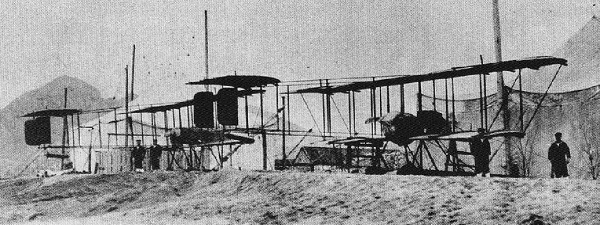
Two Japanese Naval
Biplanes at while based on land during the Siege of Tsingtao 1914
Photo from "Sabre et Pinceau"
by Christian Polak /
WikiCommons
German Pilots Uniforms
There was no authorised uniform designed for Schutztruppe pilots. Period
photographs show them wearing standard Schutztruppe uniforms (or Navy
and Marine Infantry uniforms in China) with the addition of a white
metal army (or navy) pilot's badge on the left breast in some cases.
From the few photographs that show them in flying gear it seems they
often wore double breasted leather jackets, either privately purchased
or army and navy regulation issue (based on those worn by army
automobile drivers). The same seems to be true for leather flying
helmets. Plüschow is seen in period photographs with a tight helmet of
private purchase. Trück and Büchner are both seen in period photographs
wearing regulation army leather helmets with a prominent padded hatband
and crest.
|